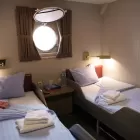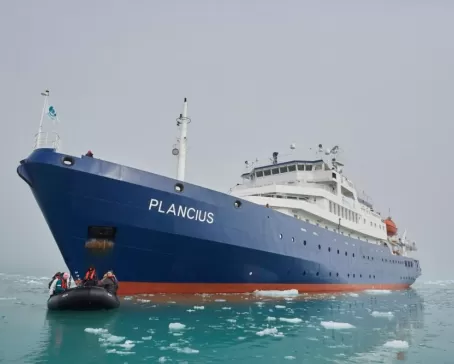Activities
Places Visited
- Africa
- Europe
- Portugal
- Spain
- Canary Islands
- West Africa
- Cape Verde Islands
- Desertas Islands
- European Union
- Madeira
- Praia
- Raso Islet
- Selvagens (Savage Islands)
Activity Level: Relaxed
Involves minimal physical effort and is typically associated with leisurely activities. Activities are low-intensity or last less than a few hours each day.
Full Itinerary
Expand AllDay 1: Praia / Embark MV Plancius
At 13.00 hours transfer to the MV Plancius for embarkation and lunch, your home for the next 8 nights. Praia is located on the southern island of Santiago, one of the largest of the 10 islands (plus 8 islets) that make up the Cape Verde archipelago. From Praia cruise north, across the ‘Ilhas do Sotavento’, towards the small islands of Raso and Branco, approximately 120 miles from Santiago, a journey that will take the rest of the day and much of the night. We will, however, be crossing prime seabird and cetacean waters and there will be plenty to enjoy en route, especially in the evening when the shearwaters and other seabirds begin to return to the islands after a day feeding out at sea. With the volcanic cone of Fogo off to our port side and flying fish scuttling over the waters surface in front of our ship, be looking out for the Cape Verde Shearwater - an endemic race of Cory’s Shearwater-plus North Atlantic Little (Boyd’s) Shearwater, Fea’s Petrel and Bulwer’s Shearwater. These waters are also home to an exciting variety of cetaceans including Short-finned Pilot Whale, Bottlenose Dolphin, Common Dolphin and perhaps Pan-tropical Spotted Dolphin and Sperm Whale.
Day 2: Raso
Spend this morning circumnavigating the small rugged island of Raso, located in the north-west of the archipelago between the larger islands of São Nicolau and São Vicente. Cape Verde Shearwaters are common here and nest in large numbers on the island along with Little (Boyd’s) Shearwater and both Madeira and White-faced Storm Petrels. The main target this morning, however, will be the beautiful and graceful Red-billed Tropicbird which also nest on Raso and can be seen here and gliding along the precipitous slopes of Branco. Brown Boobies are another key species frequently seen around the islands. Locating one of the endemic Raso Larks from the zodiacs has been proven to be a possibility.
Mid-day head northeast, away from the Cape Verde Islands and towards the continental shelf off West Africa. Have a chance to see the Western Palaearctic's only Magnificent Frigate birds. There will be plenty of commoner seabirds to enjoy, plus and opportunities to look for dolphins, pilot whales and perhaps some of the larger cetacean species.
Mid-day head northeast, away from the Cape Verde Islands and towards the continental shelf off West Africa. Have a chance to see the Western Palaearctic's only Magnificent Frigate birds. There will be plenty of commoner seabirds to enjoy, plus and opportunities to look for dolphins, pilot whales and perhaps some of the larger cetacean species.
Day 3: At Sea
At Sea. Today will be spent mostly over deep water cruising from the Cape Verde Islands to the west African shelf edge off Mauritania. Seabirds and cetaceans will be the order of the day and hope for an interesting selection of seabirds as you head east.
Day 4-5: Cruising off Mauritania and Western Sahara
Reach the shelf in the morning near Nouadihbou and spend 2 days cruising north along the shelf edge off Mauritania and Western Sahara. Here you should expect the unexpected, for these rich waters are rarely visited by naturalists. Hope that by ‘chumming’ (a potent mix of fish scraps and oil) at key points along your route you will enjoy close views of plenty of the commoner species plus a few surprises! All four species of Northern Skua - Great, Arctic, Long-tailed and Pomarine - should be common. Groups of Grey Phalaropes are also a common sight here, along with flocks of Sabine’s Gulls, European Storm-petrel, Kittiwakes and Black Terns. These northern breeders are joined from the south by Wilson’s Storm-petrels, plus Sooty Shearwater and - for the fortunate - perhaps even South Polar Skua; a species recently shown to head north into these waters during our spring and summer months. Any of the rarer seabirds breeding on the Macronesian Islands are possible, along with an exciting range of cetaceans which may include Fin Whale, Sperm Whale, Northern Bottlenose Whale, Curvier’s beaked Whale, Common Dolphin and the outside chance of rarer species such as Rough-toothed Dolphin, Blainville’s Beaked Whale and Pygmy Sperm Whale. Other pelagic wildlife to look out for includes Sunfish and even the occasional turtle.
Day 6: Canary Islands
Explore the deepwater channels around Gomera in the Canary Islands. A known hot spot for whales and dolphins. The inaugural 2011 voyage saw Sperm and Short-finned Pilot Whales plus a number of dolphins including Rough-toothed. You will now be in range for Barolo’s Shearwater, another recent species split (from Little Shearwater) plus you should expect more Cory’s Shearwaters, Bulwer’s Petrels and White-faced Storm-Petrels today too.
Day 7: Selvagens
In the afternoon reach the remote Selvagens, where you will first see Selvagen Pequina and where you will spend an evening cruising around Selvagen Grande. These isolated islands, which lie 80 miles north of the Canaries, are perhaps the ultimate destination for anyone interested in Western Palaearctic ‘tube-noses’. Huge numbers of petrels and shearwaters breed here including approximately 15,000 Cory’s Shearwaters, 5,000 Bulwer’s Petrels, 2,000 Little (Barolo’s) Shearwater, 60,000 White-faced Storm-petrels and 1,500 pairs of Madeira Storm-petrels. Since many of these species gather off shore in the evening before returning to their nest sites after dark, your evening cruise here should be one of the ornithological highlights of this holiday. If conditions permit launch the zodiacs for an evening zodiac cruise to enjoy the seabirds and cetaceans at close range.
Day 8: Desertas Islands
In the second half of the day sail by the Desertas Islands. The Desertas belong to the Madeira archipelago. In 1990 they became a Nature Reserve, comprising the islands themselves and the surrounding sea to a depth of 100 metres. The reserve is divided into two protected zones of which the southern half of Deserta Grande and Bugio are strictly forbidden to visitors even by boat. On Deserta Grande there is a permanent research station with three wardens, who are the only human inhabitants on the islands today. The Desertas were designated as Special Protection Area for their important seabird populations. Cory’s Shearwater, Bulwer’s Petrel and Madeira Storm Petrel all breed here along with Fea’s or Desertas Petrel. Observe an exciting selection of cetaceans including Common Dolphin, Bottle-nosed Dolphin, Short-finned Pilot Whale and perhaps a Fin or early Bryde’s Whale. Sperm Whales are the mostly frequently seen large whales in these waters and spend most of the year here feeding on squid from the deep water canyons and trenches that surround the islands. A population of less than 100 Mediterranean Monk Seals also live around the Desertas.
Day 9: Disembark in Madeira
The morning will find us 20 miles north of Madeira in an area where Zino's Petrel (endemic for Madeira) is known to forage. Midday arrive in Funchal, the capital of Madeira, where you will disembark the MV Plancius and transfer on your own to the airport to catch an afternoon flight home (flight not included in cruise rate).
Ship/Hotel
MV Plancius
Dates & Prices
Per person starting at

Select a Date
Quadruple Porthole4 cabins with private facilities, 2 bunk beds. (ca. 15 m2)

Select a Date
Triple Porthole4 cabins with private facilities, 2 bunk beds. (ca. 15 m2)

Select a Date
Twin with Porthole9 twin private cabins with porthole. Two Lower berths. (ca. 15 m2)

Select a Date
Twin with Window26 twin private cabins with window. Two Lower berths (ca. 15 m2)

Select a Date
Twin Deluxe2 twin private deluxe cabins. Lower berths - two single beds.(ca. 15 m2)

Select a Date
Superior10 twin superior cabins. Lower berth - double bed. (ca. 21 m2)
Notes
- Rates are quoted in U.S. dollars and represent costs per person, double or triple occupancy. Request the Twin or Triple Share Program where you are matched with a cabin mate of the same gender. Even if a cabin mate is not found for you, no single supplement will be charged.- Single occupancy: All cabins 1.7 times the share twin price
-Children between the ages of 3-15 will be discounted 40% in triple or quad cabins, one child per cabin.
- Due to the extreme nature of itinerary destinations, travel insurance is mandatory for all cruises aboard the Plancius - including medical, accident and repatriation/evacuation insurance.
Map
Inquire
The trip might have been the absolute best of our lifetime (thus far). We particularly want to commend our guide Peter in the Guilin area-he was so incredibly attentive, energetic, enthusiastic-and absolutely dedicated to ensuring that our meals were 100% vegetarian.
Jack Charney





















